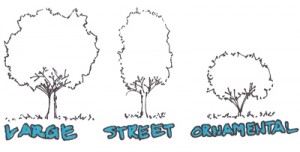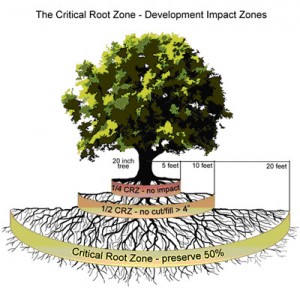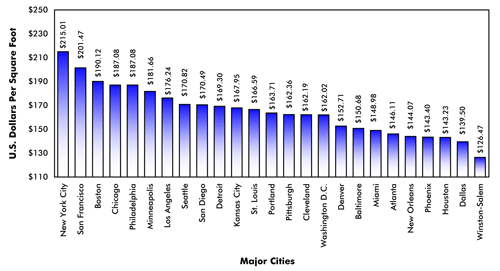The selection of an urban tree is much more complex than the typical tree. There are many factors that are involved in successfully choosing which tree works best in the urban fabric. The following are some of the factors in selecting the appropriate tree in an urban setting: Form; Branch Structure; Root Structure; pH Tolerance; Pollution Tolerance; Tree Litter; Water and Sunlight Requirements; and Aesthetics.
Form

The form of the tree is best characterized by the general mature height and width of the species. Different forms have their place in an urban landscape. For example a tree in a parking lot may want to have a large canopy for shade and the reduction of the heat island effect in a parking lot. A tree along a street may need to be more upright or fastigiate to assure that the branching does not require additional pruning to keep it away from the building. A smaller tree may be desired for intimate urban conditions, such as a courtyard. Form is also a consideration if the defined space is framing a terminated vista.
Branch Structure
The branch structure is important in choosing a tree primarily for pedestrian walkability. A street tree should allow for at least seven-feet of vertical clearance for the passing pedestrian. For many trees, this branching requires additional pruning and selection should consider pruning tolerance. For other trees, such as Quercus palustris (Pin Oak), pruning is only a temporary correction to the lower branches. The Pin Oak’s lower branches naturally droop toward the ground rather than maintain the horizontal or more vertical branching. When the lower branches are cut off, the next layer of branches naturally begin to droop. Branching is also a consideration for upright trees, where branches can form tight-‘v’ angles where ice can build up and jeopardize the health of the plant.
Root Structure
The root structure is an important consideration to prevent unwanted maintenance on the adjacent infrastructure. Trees vary by species on the depth where the roots form. Damage can be done to sidewalks, curbs, etc. if inappropriate species are selected. There are ways to avoid this including the use of a root barrier (See Urban Street Trees: Root Barrier for more information). Some roots of plant species cannot withstand the compaction that is common in urban areas. Similar to root barriers, compaction can also be avoided with structural soils and other methods.
pH Tolerance
The measure of the soils pH is an important consideration. Some plants require higher proportions of acid for the health of the plant. Others, which are more appropriate in an urban area, desire or tolerate higher levels of alkaline soils (sometimes referred to as ‘salt tolerant’). In cooler climates, this is an important consideration due to a high amount of salt used for icy roads. The salt from the roads is easily transferred to the street trees or adjacent landscape beds.
Pollution Tolerance
It is well-known that cities have higher levels of pollution. The most common form is air pollution. A primary consideration for plant material in an urban setting is the pollution from the automobile. Shrubs and trees in parking lot or along the street need to have a tolerance for the pollutants that come from our automobiles.
Tree Litter
Pollution also comes from the trees fruit and sometimes weak branches. The fruit of the tree varies by the species. The fruit classification includes common orchard fruits along with berries, pomegranates, acorns, pine cones, samaras, etc. The acorn of oak trees can cause damage to vehicles or pedestrians and the small berries from many flowering trees can create messy sidewalks that either require a lot of maintenance or are undesirable for the pedestrian.
Water and Sunlight Requirements
Trees require a great amount of water, much greater than most actually realize. Urban trees should always have supplemental irrigation because many people forget to water trees. Locating trees with flowers or shrubs provide an effective indicator of tree dehydration. For more on this, read An Urban Street Tree is Dependent on the Plant Material Around It. The sun is also a forgotten component when it comes to trees. I’m not sure why this is frequently overlooked; perhaps the designers figures the tree is tall enough to get light from above the buildings? Regardless, it is always important to ensure that the tree has enough sunlight to meet its requirements at the height/width at the time of planting.
Aesthetics
Aesthetics are always a consideration in the landscape. Plants are typically selected as a way to compliment something else. In my opinion, in an urban environment, the landscape elements should not be the primary focus from the eye. The plantings should be designed in a way to compliment the overall streetscape, which includes the architecture, street, people and vistas. The best feedback that I have received is not about a plant that I picked out, or a single courtyard space, but when the feedback is in respect to the overall place. All elements should work in concert without competition between streetscape elements.









2 thoughts on “Urban Tree Selection”
Pingback: Urban Street Tree Well — EVstudio, Architect Engineer Denver Evergreen Colorado, Central Texas Architect
Pingback: Tweets that mention Urban Tree Selection | Architecture, Engineering & Planning EVstudio | Denver & Evergreen Architect | Colorado & Central Texas | Blog -- Topsy.com
Comments are closed.